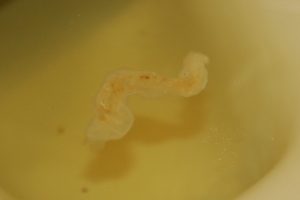Any discharge that is pinkish to light brown n color has been a serious concern of many females as it is too confusing and females find it quite tough to sort out the actual reason behind it.
It must be made clear that any normal discharge which takes place through vagina is generally clear and transparent and is free from odor. Any tint in the vaginal discharge or any unpleasant odor associated with it can be a sign of some underlying infection as well. Depending on the specific natural smell of a female, the smell of discharge is often variable but when there is an infection, it turns out to be a foul smell and is generally unpleasant as well. Likewise, how much discharge takes place through vagina is also variable depending on general health, menstruation, length of menstrual cycle and many psychological factors.
Contents
• Pinkish Brown Discharge vs. Brown Discharge:
Pinkish brown discharge through vagina is almost transparent with a little pink tint which generally appears fresh while brown discharge is generally accompanied with breakdown of endometrial tissues. Brown discharge often occurs immediately after the end of bleeding during periods which is simply assumed to be a typical vaginal cleaning. Also the color of old blood turns brown. In contrast the pink discharge from vagina is generally fresh and is mostly seen at the time of implantation of embryo in the uterine linings, some pinkish brown discharge is often seen after delivery and is associated with trauma to uterus during birth. Pinkish brown discharge which takes place before the periods is sometimes regarded as an alarm of pregnancy.
Recommended Reading :
Concerns regarding thick white discharge before period
• What is More Confusing About Pinkish Brown Discharge?
It is quite natural to be worried about any discharge which is tinted and shows a little deviation from norm. It is not possible however to find out the exact reason of pinkish brown discharge but it is associated with implantation and is seen generally during pregnancy.
Under normal conditions, the brownish discharge takes place through vagina and is generally seen after menstrual period. Sometimes due to the late onset of periods one may experience brown discharge, but the pinkish brown discharge is different as it appears too fresh. Although in most of the cases it is linked with the cleaning of uterine tissues and cervix dead cells along with considerable amount of mucus which is discharged from the mucus linings, sometimes the pink discharge can be a signal of underlying health condition of female reproductive tract. Spotting on birth control is also one of the concerns in females.
• Pink Spotting Between Periods:
There can be so many questions in mind regarding pink spotting between periods, it is serious concern for all those females who are trying to conceive and are seriously concerned about their sexual health. Pinkish spotting between periods is considered to be linked with ovulation. The process of release of an egg from female’s ovary is known as ovulation. According to latest research some females do experience light pink spotting followed by ovulation. It is assumed that during ovulation as egg is released out of the ovary, it might also result in the bursting of egg, at the same time hormonal changes in body also are at peak during the process of ovulation which can result in pink spotting between periods. It has to be kept in mind however, that it is highly uncommon and very few females are likely to experience this.
Another cause of pinkish spotting between periods is implantation bleeding which occurs when embryo implants itself to the uterine linings. Implantation is thought to take place ten to fourteen days after conception. Implantation requires the embedding of embryo in the uterus walls and some cells are shed down along with blood which appears to be light pink in color. The bleeding is somewhat related to a short period. The implantation bleeding is not likely to happen to all females, only few females experience this.
• Spotting While On Birth Control:
Many females often discover that along with the intake of contraceptive or birth control pills, they experience light periods which are often less painful as well. Spotting while on birth control is common since the pills you are taking can cause bleeding. Hence if you are spotting while on birth control, there is nothing to worry as it is natural phenomenon. However if you experience heavy bleeding with birth control methods, you need to consult health care provider soon. Read this info Symptoms of std
• Why am I Spotting While On Birth Control?
Spotting while on birth control is quite common as contraceptive pills do affect hormones. This is too common as you start taking the pills with the passage of time however the body will adjust to the hormonal changes and there will lesser chances of such occurrences. Spotting while on birth control is normal but if you experience heavy bleeding, you must consult your doctor.
• How to Stop Spotting While On Birth Control ?
It is normal to have some occasional spotting on birth control especially when you start taking birth control pills; this spotting is likely to go away of its own after 3-4 months. But sometimes females also experience heavy bleeding and stop their medication which must be discouraged. Continue with the birth control pills and contact your health care provider. There is also a possibility that a specific birth control pill you are taking is not suiting you and as a result you are experiencing some side effects. Your doctor might help you to find some alternate birth control method to make you feel well again. To sum up spotting on birth control is normal and many of the symptoms fade away in 3-4 months.
• Pinkish Brown Discharge After Periods:
Pinkish brown discharge after periods is quite normal; it is considered that some of the dead uterine cells which were not completely removed during periods are shed down along with mucus. It is quite normal and is sometimes also related to ovulation as well. On the other hand spotting on birth control often assumes pinkish brown discharge which highlights some underlying hormonal changes in the body.
• Pinkish discharge during early pregnancy:
During early pregnancy, it is common to experience pinkish discharge; there are many causes of pinkish discharge during early pregnancy. Some of which are discussed under:
Pinkish brown discharge in seven weeks pregnant female is thought to be related with implantation bleeding, as the embryo implants itself in the uterus some cells are shed along with mucus which results in pinkish brown discharge during early pregnancy.
Pinkish brown discharge in nine weeks pregnant female is mainly due to the hormonal changes and the gestational sac formation which causes the shedding of some extra cells out of the uterus in the form of pinkish brown discharge.
• Pink Brown Discharge Before Periods:
Pink brown discharge before periods is generally caused some times due to implantation in case of conception. It has to be kept in mind that pinkish or brownish discharge before menstruation is a clear indication of pregnancy. While in teens the pink brown discharge before periods is linked to hormonal changes. As they grow up, the hormones will get stable and spotting fades away.
• Pinkish Brown Discharge After Periods:
During menstruation the dead cells of uterus are discharged through vagina along with considerable amount of blood, the breakdown of egg and mucus from cervix and vaginal linings. Menstruation is regarded as cleaning of uterus and making it ready to enter the next phase where conception might takes place. Sometimes, some females experience pinkish brown discharge after their periods, this discharge is related to cervical and vaginal cleaning. Hence if any discharge occurs after periods, it is quite normal but in case of heavy bleedings and other symptoms like smell, headaches and mood swings, do talk to your health care provider.

Some other Causes of Pinkish Brown Discharge:
As we have discussed above that pinkish brown discharge is linked with implantation and is a sign of pregnancy, sometimes, the pinkish brown discharge is caused due to certain other reasons, some of which are discussed under:
• Puberty:
It is quite common for teens to have pink spotting between periods and is considered to be due to hormonal imbalance. Young girls often notice pink brown discharge before the onset of menstruation and this might happen few years before the start of menstruation or reaching puberty.
• Menopause:
Hormonal storms are experienced at puberty and at the same time females might experience a drastic change of hormonal level before the onset of menopause. The general age for menopause is above 50 but it greatly depends on the health condition as well as environmental conditions around the females. If you are above the age of 50 and experience spotting, you can consult the doctor however it is considered normal most of the times.
• Pregnancy:
The menstruation stops immediately once the female conceives. This is to add the vascularity of uterine linings and to keep them well supplied with blood to nourish the under developing embryo or fetus. However, the pinkish discharge is linked with the marker of pregnancy in most of the cases as it results mainly after implantation.
• Stress and emotional disturbance:
When a female is under acute stress or emotional disturbance is at peak, there is a huge impact of this on ovulation and as a result of which hormonal imbalance is likely to occur. Whenever there is a hormonal imbalance, you can experience pink brown discharge. However, this discharge will go away after a short time and involves just a little time.
• Fibroids:
Fibroid tumors are common condition in females, since these tumors are benign, there is nothing much to worry about it. The fibroids tend to grow longer and longer with the passage of time, the presence of fibroids in the uterus is also associated with pinkish brown discharge. Hence if your pink brown discharge is accompanied by lower abdominal pain, occasional bleedings and pelvic pressure, you must consult your doctor. The surgical invasion is normally needed where hysterectomy takes place and uterus of the female is removed.
• Polyps:
These are the outgrowths which are formed either in uterus or cervix. The polyps which are growing inside the uterine linings are known as endometrial polyps and are one of the common conditions in females. The polyps particularly the endometrial polyps hang out from the uterus the way similar to figs. If polyps are found in uterus, female may experience pink or brown discharge especially when the polyps are disturbed.
• Adenomyosis:
It is a condition in which the uterine linings start growing inside the uterine cavity. As a result of this abnormal growth, some blood cells remain trapped there. With the accumulation of much blood, you may often experience pink brown discharge and is accompanied by several other symptoms like lower abdominal cramps, pelvic pressure, uterine cramping and heavy bleeding at certain occasions.
• Pelvic inflammatory disease:
One of the causes of females experiencing light brown to pinkish brown discharge is pelvic inflammatory disease which is known commonly as PID. The disease is characterized by infection in fallopian tubes or sometimes ovaries are infected as well. This condition may result in some other changes in the body like severe to moderate itching, pain, cramping along with pinkish brown discharge. Bad odor in females is also the result of PID, once you notice the symptoms, talk to your doctor without any hesitation.
Hence we can safely conclude that pinkish brown discharge before periods, pinkish brown discharge after periods is a common factor in females but if accompanied by certain other symptoms like pain or cramping along with considerable bleeding, you must consult your doctor to rule out the risk of some key health concerns.
Related post :Brown mucus discharge in females











